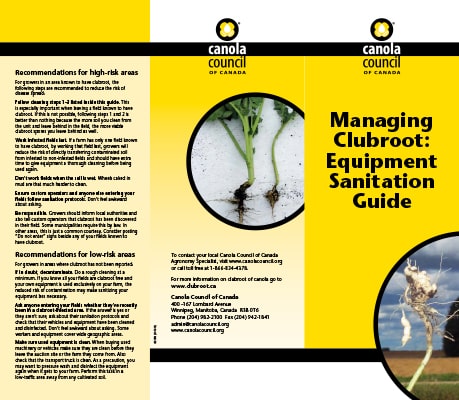Moving soil means moving pests. The list includes:
- Plasmodiophora brassicae (canola pathogen causing clubroot)
- Verticillium longisporim (canola pathogen causing verticillium stripe)
- Aphanomyces euteiches (pea and lentil pathogen causing aphanomyces root rot)
- Phytophthora sojae (soybean pathogen causing phytophthora root rot)
- weed seeds
- nematodes
- possibly insect pupae
Anything that moves soil can move these pests across a farm and from farm to farm. Soil moves by wind and water erosion, by animals and ATVs, by drills and combines. Anything that keeps soil in place – like equipment sanitation and reduced tillage – will reduce the spread of these pests.
Farm machinery can be a highly efficient way to spread hundreds of pounds of infested soil a long distance and very quickly. And yet it can take only a few grams of soil to introduce a problem pest. Wet soil conditions increase the amount of soil that clings to tires and openers.
How to clean
To clean equipment before leaving a field, choose an appropriate worksite where soil can be removed and then not picked up again when exiting the field. A low-traffic grassed area near the field exit is an ideal place to sanitize equipment.
Step 1: Rough cleaning. A long-handled tool, such as a shovel, hoe or ice scraper, will easily remove large soil clumps from openers and frames. A hand scraper, wire brush and/or compressed air will remove smaller debris. This combination could take an hour or more for an average sized seeding tool, and should remove at least 90% of the soil from the unit.
Step 2: Fine cleaning. Use a pressure washer at 2,000–3,000 psi on all areas where soil can accumulate. Turbo nozzles are generally more effective at removing soil than regular nozzles. Addition of an industrial detergent may enhance the degree of soil removal. Steps 1 and 2 in combination should remove 99% of soil from the unit.
Step 3: Disinfection. This will achieve near complete removal of the clubroot pathogen. We don’t know if this is effective or necessary for the other pests. A 3-gallon backpack herbicide sprayer will work to apply disinfectant on all surfaces. For clubroot, bleach is the best performer, but bleach has its disadvantages. (More on the options.) All areas should remain wet with the solution for 15–20 minutes. Disinfecting in the early morning or in the evening slows evaporation so a second or third application may not be necessary to keep the area wet for the required time. Step 3 alone is not effective. The first two steps are required if you plan to include the disinfection step.
It may not be practical to follow all steps every time machinery leaves a field. The more soil removed in step one, the fewer pathogen spores, weed seeds and nematodes that are spread.
Used machinery
Machinery purchased from another area could contain these pests. Before bringing it home, check that it’s clean outside and inside. If not, cleaning should be done at the purchase location. As a precaution, pressure wash the equipment on arrival at the destination farm. Do this in a commercial truck wash or in a low-traffic grassed area away from any cultivated soil.
Provincial weeds acts require thorough cleaning of equipment (like combines) that could bring in noxious weeds. For example, the Manitoba Noxious Weed Act section 5(3) says:
5(3) If an inspector reasonably believes that a noxious weed may be present in or adhering to an item mentioned in subsection (2), the inspector may
- (a) give a written notice to the person in possession of or in charge of the item requiring the person, without delay and before the item is moved, to have it thoroughly cleaned, inside and out, and to destroy any noxious weeds in it or adhering to it; and
- (b) if the notice is not promptly complied with, take any measures that the inspector considers necessary to destroy whatever noxious weeds may be in or adhering to the item. Read the whole Act, including subsection (2)
The Saskatchewan Weed Control Act has similar provisions regarding the cleaning of “vehicles and machinery” before moving them between fields.

